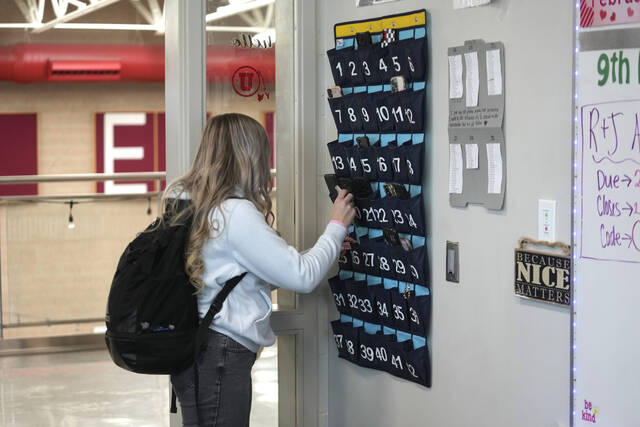Editorial: Are cellphone bans the right move for schools?
There are a lot of things kids shouldn’t be using in class.
They shouldn’t have guns or knives or bullets. They shouldn’t have drugs or cigarettes or alcohol. They shouldn’t be bringing in anything that distracts from their learning or creates a hostile environment.
Some schools have interpreted these ideas to limit how short a girl’s shorts can be or what can be written on a T-shirt. Some parents have pushed for limits to the books in the library or the lessons in the curriculum.
But what is getting the attention right now? The technology that seems bolted to every student’s hand.
Pennsylvania lawmakers passed a bill this year encouraging schools to limit access to cellphones during the school day. To support that, grants would be available to buy locking bags for depositing the devices and keeping them unavailable during class. To qualify, the school districts need to adopt a policy locking down phones.
It is an idea that has support in the data. Pew Research Center says 95% of teens have a cellphone or at least have access to one — and 38% of those kids think they spend too much time on that tech.
How do they feel when those devices are out of sight? Often or sometimes happy, say 74% of surveyed teens; peaceful, say 72%. Much smaller numbers report negative feelings such as anxiety or loneliness. Just 7% say they are often upset when their phones are unavailable.
Aside from the positive emotions, there are practical reasons for the policies. Teachers with 20 or more students in a class have enough competition for adolescent attention. They don’t need the constant din of pinging, ringing or buzzing phones pulling tweens or teens away from English or algebra.
Finding a way to safely secure devices during class makes sense. But so does ensuring access in the event of need.
High schools don’t have pay phones to call home because of illness or transportation needs the way they once did. They aren’t necessary when everyone carries a phone. But those are also situations that can be handled by a trip to the office.
What can’t be guaranteed that way is a traumatic event such as the active shooter situation that unfolded last week in Winder, Ga. Students know that could happen. They train for those situations in drills the way their grandparents trained for nuclear bombs. The difference? No students were ever killed by nuclear bombs while hiding under their desks.
Our children today live in a world where they know tragedies can unfold at school. We also know there are people whose last contact with their loved ones in unimaginable disasters came from a phone call or text message.
Should there be steps taken to make school a refuge from the chaos of connectivity and social media? Yes. But it also needs to be a refuge from violence — and there has been less progress on that front.
With that in mind, sure, lock up the phones. Create an oasis for learning. But make sure the phones are still there as a lifeline and escape hatch in the event something terrible and, unfortunately, predictable occurs.
Remove the ads from your TribLIVE reading experience but still support the journalists who create the content with TribLIVE Ad-Free.

